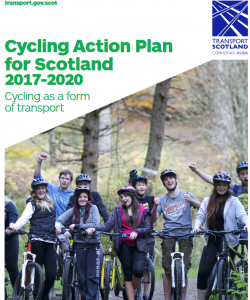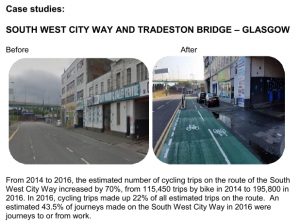The Scottish Government’s third Cycling Action Plan for Scotland (2017-2020) follows the pattern of CAPS1 and CAPS2 – a collection of increasingly useful & positive initiatives, but not an evidence-based, costed and funded programme to achieve its “unshakeable” commitment to 10% of all trips being by bike in 2020.
This is hugely disappointing, given that Cycling Scotland’s brave analysis of CAPS2 did take cognisance of evidence from other countries and from the many organisations who responded to its consultation (including our own Spokes response). Cycling Scotland said (as quoted in CAPS3)…
“A long term increase in sustained funding is required, with year-on-year increases over time towards a 10% allocation of national and council transport budgets as Edinburgh is achieving. The long term commitment to 2030 to dual carriageways between seven Scottish cities should be matched by an equally long term commitment to cycling if modal shift ambitions are to be met and sustained.”
But the Government’s response in CAPS3 is…
“The Scottish Government’s position is that levels of transport spend cannot simply be based on percentage allocations for each transport mode. The overall transport budget must reflect existing contractual requirements, planned maintenance and upgrades and it would be wrong to arbitrarily allocate definite amounts to any one mode.”
We could take this response seriously if the government had itself produced an evidence-based argument as to the level of funding required to achieve the 2020 vision, but it has not. Instead, the level of cycling investment seems based on keeping the same level as before except when outside pressure is strong enough to force an increase. Whilst it is true that present funding levels are “at record levels” (£39.2m per year since 2014/15) this represents a mere 1.6% of the draft 17/18 Scottish transport budget.
Indeed the whole transport budget could do with a fundamental re-assessment, based on maximising transport’s contribution to the government’s underlying objectives, including public health, climate, equalities, economy, etc. It would be lovely to think this might achieved via the government’s review of the National Transport Strategy – please send them your views!!
In fact there are strong evidence-based reasons why 10% of the transport budget for active travel makes a great deal of sense. This is discussed in sections 6 and 2 of our pre-budget submission.
Actions in CAPS3
Despite the above fundamental failure, CAPS3 does includes many excellent individual actions and initiatives – and in general the set of actions improves with each new CAPS, from CAPS1 to CAPS3. Here we just comment on a few which could be strengthened and/or which particularly interested us for other reasons…
- [p19] 20mph policies. It is disappointing that the Scottish Government remains unwilling to set a default 20mph limit (with powers to excempt specified roads) in urban areas. Nonetheless, the strong support for 20mph in other respects is welcome.
- [p12] Community Links Plus (CL+). This is a great initiative encouraging councils to bring forward “exemplary” cycle projects which re-allocate roadspace to create segregated cycleroutes. Unfortunately no new cash has been provided for the scheme, as a result of which…
- the cash has been removed from the basic Community Links scheme which funds large numbers of smaller projects right across Scotland
- only one or two of the CL+ proposals can actually be built – yet even the shortlist for this year has 10 excellent projects bidding for the cash.
- [p7,15,16] Trunk Road Cycling Initiative. It is great to see this 20-year-old policy being ‘refreshed,’ as we have long urged [e.g. our 2015 le
 tter; govt reply]. The wording in CAPS3 is more restrictive than we would like, referring only to including cycling in trunk road upgrades, but it needs also to cover cycling schemes where the trunk road itself is not being upgraded.
tter; govt reply]. The wording in CAPS3 is more restrictive than we would like, referring only to including cycling in trunk road upgrades, but it needs also to cover cycling schemes where the trunk road itself is not being upgraded.
- [p18] Bike/rail on West Highland Line. We are pleased to see that last year’s furore over the planned big cuts to bookable bike spaces has resulted in what appears to be a significant multi-organisation collaboration to improve the situation.
- [p31] Glasgow Tradeston segregated cycleroute. CAPS3 includes some interesting case studies, including the above which helps confound any sceptics who think that segregated main road cycleroutes might not work in Scotland!
2020 Vision
Spokes strongly supports the government’s wish for 10% of all trips to be by bike – and we do all we can to encourage that locally through our volunteer efforts – lobbying, producing and distributing fantastic bike maps, holding stalls at festivals, and in many more ways.
However it is time the government acknowledged that given the levels of funding it has allocated up to now, and continues to allocate (1.6% of the draft 17/18 transport budget, down from 1.8% this year) there is zero prospect of reaching the 10% vision by 2020. What is more, CAPS3 [page 7] suggests that the government intends no increase until 2021 at the soonest – it refers to £280m for the 7 years from 2014/15, which implies maintaining the current £39m/£40m per year throughout this Parliament.
We were amazed therefore that the 2015 SNP Holyrood manifesto expressed “determination” to achieve 10% cycle use by 2020 – without any increase in funding – and now the Minister’s introduction to CAPS3 promises an “unshakeable commitment“ – again without any increase in funding.
Independent bodies such as the Scottish Parliament Information Service, SPICe, have made clear this is no longer possible… “it seems clear that the vision of 10% of everyday trips in Scotland being made by bike by 2020 will not be met” [SPICe Bulletin 16/33, May 2016]. Cycling Scotland’s Second CAPS Progress Report [June 2016] states that 10% by 2020 would require “a modal shift to cycling at a speed not seen in evidence in any other country.”
At current investment levels, cycle use is rising only very slowly, forming roughly 1.2% of all trips in 2015 [Scottish Household Survey] and only somewhat better for work trips [CAPS p23].
WHAT YOU CAN DO
- Retweet our tweet about this story
- Email your MSPs now to get changes in the draft 17/18 budget
- Send your ideas to the National Transport Strategy Review consultation [send us a copy of your email]
- For a fuller understanding of the issues, read our pre-budget submission.
